Introduction:
The Pikes Peak roast is a unique and flavorful cut of beef that has gained popularity for its tenderness and rich taste. Named after the iconic Pikes Peak mountain in Colorado, this roast comes from the shoulder region of the cow, specifically from the chuck section. Known for its rich marbling, the Pikes Peak roast offers a balance of flavor and tenderness that sets it apart from other beef cuts. Whether you’re a seasoned cook or a beginner, this versatile roast is perfect for a variety of cooking methods, making it a fantastic choice for any meal.
What makes the Pikes Peak roast so special is its combination of flavors and textures. Unlike other cuts of beef, the Pikes Peak roast is marbled with fat, which helps to keep the roast moist and tender during cooking. While the chuck section can sometimes be tough, the Pikes Peak roast benefits from its careful trimming and slow-cooking techniques, which break down the muscle fibers, resulting in a melt-in-your-mouth tenderness. The flavor is rich and beefy, with a depth that enhances any dish it’s part of, whether it’s a holiday dinner or a weeknight roast.
In this comprehensive guide, you will learn everything you need to know about preparing and cooking a Pikes Peak roast. We’ll cover the best cooking methods, including roasting, braising, and grilling, so you can choose the right technique for your taste. We’ll also share expert tips for marinating, seasoning, and pairing your roast with complementary side dishes to elevate your meal. Additionally, we’ll provide mouthwatering recipes to help you make the most of this delicious cut of meat.
What is Pikes Peak Roast?
The Pikes Peak roast is a flavorful and tender cut of beef that comes from the shoulder region of the cow, specifically the chuck primal. This cut is known for its rich flavor, tenderness, and versatility, making it an excellent choice for a variety of cooking methods. Though it originates from the chuck section, which can be tougher compared to other cuts, the Pikes Peak roast is carefully trimmed and prepared to provide a more tender and juicy eating experience. Whether you’re roasting, braising, or slow-cooking, this roast delivers outstanding flavor and texture every time.
Origin of the Name: Pikes Peak Region
The Pikes Peak roast gets its name from the famous Pikes Peak region in Colorado Springs, a majestic area known for its mountainous landscapes. While the roast itself doesn’t come directly from this region, the name is used to evoke the bold, hearty flavors that are reminiscent of the rugged outdoors. This connection to the Pikes Peak area adds to the uniqueness and character of the roast, making it a special cut that celebrates both the history and natural beauty of Colorado.
Nutritional Value and Flavor Profile
The Pikes Peak roast offers a rich, beefy flavor that is complemented by a satisfying tenderness. It’s known for being a leaner cut than fattier roasts like ribeye, but it retains enough marbling to ensure a juicy and tender result when cooked properly. The nutritional profile of the Pikes Peak roast per 3.5-ounce (100-gram) serving is as follows:
- Calories: 200–250
- Protein: 22–25 grams
- Fat: 10–15 grams
- Carbohydrates: 0 grams
- Iron: 2–3 milligrams (important for energy and immune function)
- Zinc: 4–5 milligrams (supports a healthy immune system)
This nutritional breakdown makes the Pikes Peak roast an excellent choice for those looking to enjoy a nutrient-dense meal that is high in protein, iron, and other essential vitamins and minerals. The rich marbling of the roast contributes to its deep, savory flavor, and when cooked with the right techniques, the roast stays tender and moist, making it a favorite for slow-cooking and roasting.
Pikes Peak Roast vs. Chuck Roast vs. Brisket
Although the Pikes Peak roast, chuck roast, and brisket all come from different parts of the cow, they each offer unique textures, flavors, and cooking characteristics. To help you better understand how these cuts compare, here’s a detailed comparison:
| Feature | Pikes Peak Roast | Chuck Roast | Brisket |
|---|---|---|---|
| Origin | Shoulder (Chuck Primal) | Shoulder (Chuck Primal) | Chest (Brisket Primal) |
| Texture | Tender, juicy with slight chew | Tougher, but becomes tender when slow-cooked | Very tender with long cooking times |
| Flavor | Rich, beefy, savory | Rich, beefy, but can be fatty | Rich, smoky (if smoked), beefy |
| Best Cooking Methods | Roasting, slow-cooking, braising | Slow-cooking, braising, pot roast | Smoking, slow-cooking, braising |
| Nutritional Content | Moderate fat, high protein | Higher fat content than Pikes Peak roast | Moderate fat, high protein, rich in collagen |
| Price | More affordable than brisket, but more costly than chuck | Budget-friendly | Generally more expensive than both Pikes Peak and chuck |
| Ideal Use | Family meals, holiday dinners, slow-cooked dishes | Pot roasts, shredded beef, slow-cooked stews | Barbecue, long-cooked brisket, corned beef |
Why Choose the Pikes Peak Roast?
When selecting a roast for your next meal, the Pikes Peak roast offers an ideal balance of flavor, tenderness, and versatility. Compared to the chuck roast, which can be tougher and requires longer cooking times to become tender, the Pikes Peak roast is known for its relatively tender texture, even without the need for extensive cooking. Unlike brisket, which is typically smoked or braised over long periods, the Pikes Peak roast can be cooked in less time and at a more affordable price point, making it a great option for both casual and special meals.
The Pikes Peak roast also offers a robust beef flavor with the right amount of marbling, ensuring that it remains juicy and tender after cooking. Whether you choose to slow-roast it, braise it, or cook it in a slow-cooker, the Pikes Peak roast will provide a delicious and satisfying meal every time.
Best Ways to Cook Pikes Peak Roast
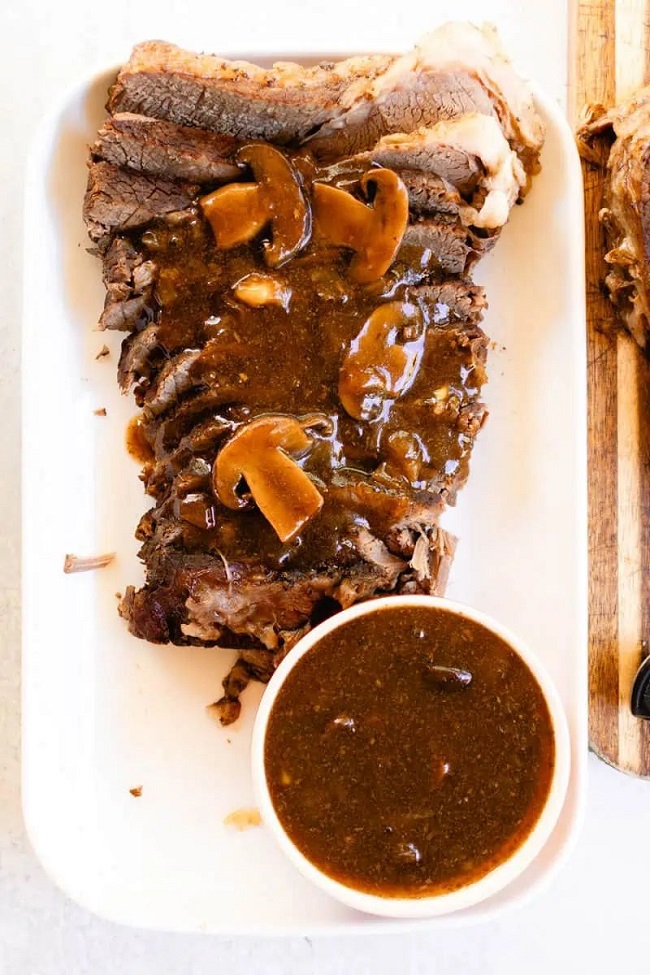
The Pikes Peak roast is a flavorful and versatile cut of beef that delivers incredible tenderness and a rich, beefy flavor. Whether you’re looking to slow-cook it for hours, roast it in the oven, or even grill or smoke it, the Pikes Peak roast can be cooked in various ways to enhance its natural qualities. In this guide, we’ll explore the best ways to cook a Pikes Peak roast, ensuring that every method brings out the roast’s full flavor and tenderness.
Slow Cooker Pikes Peak Roast
The Pikes Peak roast is perfect for slow cooking, which tenderizes the meat while infusing it with rich flavors. This low-and-slow method is ideal for people who want a hands-off approach to cooking a delicious roast. The slow cooker allows the roast to cook over several hours, ensuring a tender and flavorful result every time.
Low & Slow Method Explained
Cooking a Pikes Peak roast in the slow cooker involves using low heat over several hours to break down the tough connective tissues, resulting in a melt-in-your-mouth texture. This method is fantastic for busy cooks, as you can set the roast and let the slow cooker do all the work. The combination of the low temperature and long cooking time helps the roast retain moisture and absorb the flavors of herbs, spices, and broth.
Cooking Time, Temperature, Step-by-Step Process
- Ingredients:
- 3-4 lb Pikes Peak roast
- 1 onion (sliced)
- 4 garlic cloves (minced)
- 1 cup beef broth or water
- 2 tablespoons olive oil
- Salt and pepper to taste
- Fresh herbs like rosemary or thyme
- Steps:
- Sear the roast: Begin by heating olive oil in a pan over medium-high heat. Sear the Pikes Peak roast on all sides until browned (about 3-4 minutes per side).
- Transfer to the slow cooker: Place the roast in the slow cooker, then add sliced onions, garlic, and beef broth. Season with salt, pepper, and fresh herbs.
- Cook on low: Set the slow cooker to low and cook the roast for 6-8 hours, or until it is tender and easily shreds with a fork.
- Rest and Serve: Once the roast is done, remove it from the slow cooker and let it rest for 10 minutes before slicing.
Tenderizing Tips
- Sear the roast first: Searing the Pikes Peak roast before placing it in the slow cooker enhances the flavor by creating a caramelized crust.
- Add enough liquid: Be sure to add enough broth or wine to the slow cooker to keep the roast moist as it cooks.
- Patience is key: The key to achieving maximum tenderness is slow cooking the roast on low heat for several hours. Avoid cooking on high, which may result in tougher meat.
Oven-Baked Pikes Peak Roast
Baking a Pikes Peak roast in the oven results in a beautifully browned, flavorful roast with a tender interior. This method is ideal for those who enjoy the combination of a crispy exterior and a juicy, flavorful interior.
Seasoning Ideas
For a delicious, aromatic Pikes Peak roast, season it with a variety of herbs and spices. Some excellent seasoning combinations include:
- Garlic and rosemary: A classic combination that infuses the meat with aromatic flavors.
- Onion powder and black pepper: Simple but effective, this combination enhances the natural beef flavor.
- Herb crust: A mix of thyme, oregano, and basil can create a fragrant herb crust for your roast.
Cooking Temperature & Roasting Guide
- Preheat the oven to 325°F (165°C).
- Season the Pikes Peak roast with your desired herbs and spices.
- Place the roast on a roasting rack in a pan, fat side up.
- Roasting time: Roast the meat for about 20-25 minutes per pound. For example, a 3-pound roast will take approximately 1 hour to 1 hour and 15 minutes to reach the desired doneness.
- Internal temperature: For medium-rare, remove the roast when it reaches an internal temperature of 135°F (57°C). For medium, remove it at 145°F (63°C).
Resting & Carving Method
Once your Pikes Peak roast is done, let it rest for at least 10-15 minutes before carving. This resting period allows the juices to redistribute within the roast, ensuring it remains juicy and flavorful. When carving, slice against the grain for the most tender results.
Instant Pot or Pressure Cooker Pikes Peak Roast
If you’re short on time but still want a tender and flavorful Pikes Peak roast, using an Instant Pot or pressure cooker is a fantastic option. This method speeds up the cooking process while maintaining the roast’s tenderness and rich flavor.
Faster Cooking Method
- Ingredients:
- 3-4 lb Pikes Peak roast
- 1 cup beef broth
- 1 onion (sliced)
- 4 garlic cloves (minced)
- Salt, pepper, and herbs to taste
- Steps:
- Burn the cook: Utilizing the “Sauté” work on the Moment Pot, burn the Pikes Crest cook on all sides for around 3-4 minutes each.
- Add liquid and seasoning: Once seared, add the beef broth, onion, garlic, salt, pepper, and herbs to the Instant Pot.
- Pressure cook: Seal the Instant Pot and set it to “Manual” mode for 60-75 minutes on high pressure, depending on the size of the roast.
- Natural release: Allow the pressure to naturally release for 10-15 minutes, then open the pot.
- Rest and serve: Remove the roast from the Instant Pot, let it rest for a few minutes, then slice and serve.
Maintaining Tenderness & Flavor
- Sear the roast first: Searing the Pikes Peak roast before pressure cooking creates a flavorful crust and helps lock in juices.
- Use enough liquid: Ensure that there is sufficient liquid in the Instant Pot to create steam, which is essential for maintaining moisture during the cooking process.
Smoked or Grilled Pikes Peak Roast
For those who love smoky flavors, smoking or grilling a Pikes Peak roast adds a rich depth to the meat. The process of slow-smoking infuses the roast with woodsy flavors while keeping it juicy and tender.
Smoking Wood Types
When smoking a Pikes Peak roast, the type of wood you use can significantly impact the flavor. Here are some great options:
- Hickory: Offers a strong, smoky flavor that pairs well with beef.
- Oak: A more neutral wood that gives a mild smokiness, making it ideal for longer cooking times.
- Cherry: Adds a sweet, subtle smokiness, perfect for a lighter smoked flavor.
BBQ-Style Preparation
- Preheat your smoker or grill to 225°F (107°C).
- Rub the Pikes Peak roast with a BBQ seasoning mix or your favorite rub, making sure it is evenly coated.
- Place the roast on the smoker or grill, fat side up. Smoke for 4-6 hours, depending on the size of the roast, until it reaches an internal temperature of 135°F (57°C) for medium-rare or 145°F (63°C) for medium.
- Baste with sauce: If you prefer, baste the roast with BBQ sauce during the last hour of cooking for extra flavor.
- Rest before carving: After smoking, allow the roast to rest for 10-15 minutes before slicing.
Additional Tips for Smoking/Grilling
- Indirect heat: For grilling, cook the roast using indirect heat to ensure it cooks slowly and evenly.
- Wood chips: Soak wood chips in water for 30 minutes before adding them to the smoker for a smoother, less harsh smoke flavor.
Best Seasonings & Marinades for Pikes Peak Roast
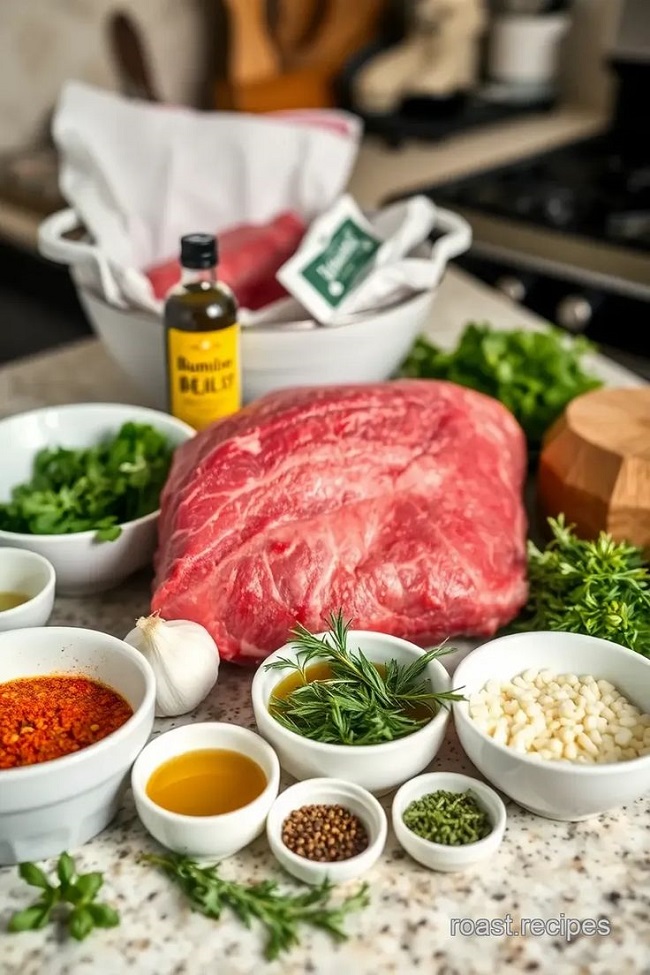
The Pikes Peak roast is a flavorful, tender cut of beef that benefits greatly from the right combination of seasonings and marinades. Whether you prefer a classic dry rub or a flavorful wet marinade, these seasoning techniques can elevate the natural flavors of the Pikes Peak roast, making it even more delicious. In this guide, we’ll explore the best seasonings and marinades for Pikes Peak roast, including classic dry rubs, wet marinades, and regional flavor variations. With the right ingredients, you can create a perfectly seasoned roast that will impress at every meal.
Classic Dry Rub for Pikes Peak Roast
A dry rub is a simple yet effective way to season your Pikes Peak roast. The dry rub creates a flavorful crust on the surface of the meat while allowing the rich, beefy flavor of the roast to shine through. It is a quick, no-mess option that infuses the roast with savory and aromatic flavors.
Popular Dry Rub Ingredients:
- Garlic powder: Adds a savory and aromatic depth to the beef.
- Paprika: Imparts a sweet, smoky flavor that enhances the natural beef taste.
- Thyme: This herb adds an earthy, fresh note that complements the richness of the Pikes Peak roast.
- Black pepper and salt: These essential seasonings help enhance the flavor and balance the beef’s natural richness.
Step-by-Step Dry Rub Application:
- Mix the seasonings: In a small bowl, combine garlic powder, paprika, thyme, black pepper, and salt.
- Prepare the roast: Pat the Pikes Peak roast dry with paper towels to remove excess moisture.
- Apply the rub: Rub the seasoning mixture generously over the entire surface of the roast, pressing the seasonings into the meat.
- Rest before cooking: Let the roast sit for 30 minutes to an hour before cooking, allowing the dry rub to penetrate the meat.
This simple yet flavorful dry rub is perfect for roasting or grilling your Pikes Peak roast, resulting in a savory and aromatic crust that enhances the meat’s natural taste.
Wet Marinades for Pikes Peak Roast
If you prefer a more intense flavor profile, marinating your Pikes Peak roast is an excellent option. Wet marinades not only infuse the meat with deep, complex flavors but also help to tenderize it. The acidic ingredients in the marinade work to break down the tough fibers, resulting in a tender and juicy roast.
Popular Wet Marinade Ingredients:
- Red wine: Adds complexity and richness, helping to elevate the beef’s natural flavor.
- Soy sauce: A savory ingredient that imparts a deep umami flavor and enhances the roast’s taste.
- Vinegar: The acidity helps tenderize the roast while brightening the overall flavor profile.
- Garlic and fresh herbs: These ingredients add aromatic depth and freshness, enhancing the roast’s overall flavor.
Step-by-Step Marinade Preparation:
- Mix the marinade: In a bowl, combine 1 cup of red wine, 2 tablespoons of soy sauce, 1 tablespoon of vinegar, 4 minced garlic cloves, and fresh rosemary and thyme.
- Marinate the roast: Place the Pikes Peak roast in a resealable plastic bag or shallow dish, then pour the marinade over the roast, ensuring it’s fully coated.
- Refrigerate and marinate: Let the roast marinate in the refrigerator for 8-12 hours, or for at least 2-3 hours if you’re short on time.
- Cook as desired: After marinating, remove the roast from the marinade and cook it using your preferred method, such as roasting or grilling.
This red wine and soy sauce marinade infuses the Pikes Peak roast with a rich, savory flavor, making it perfect for any roast or BBQ.
Regional Variations for Pikes Peak Roast
The Pikes Peak roast is versatile enough to be adapted to various regional flavor profiles. Here are a few regional variations that can bring exciting new flavors to your roast:
American BBQ Style
For a classic American BBQ-inspired Pikes Peak roast, focus on smoky, tangy, and slightly sweet flavors. BBQ rubs and marinades are typically loaded with flavors like brown sugar, chili powder, and mustard.
- BBQ dry rub: Brown sugar, paprika, chili powder, garlic powder, onion powder, salt, and black pepper.
- BBQ wet marinade: Combine vinegar, mustard, ketchup, brown sugar, Worcestershire sauce, and spices to create a tangy, sweet marinade for the roast.
This American BBQ style works exceptionally well when grilling or smoking your Pikes Peak roast, creating a flavorful, caramelized crust with a smoky depth.
Italian Herb Style
For an Italian-inspired Pikes Peak roast, use herbs like oregano, basil, and rosemary for a fresh, aromatic flavor. This style works particularly well for roasting, slow cooking, or braising.
- Italian herb marinade: Mix olive oil, balsamic vinegar, minced garlic, fresh rosemary, oregano, and thyme for a savory, herbaceous marinade.
- Italian dry rub: Combine dried oregano, basil, garlic powder, onion powder, salt, and pepper to create a fragrant rub that adds a burst of Italian flavor to the roast.
This Italian seasoning variation is perfect for oven roasting or slow cooking, creating a fresh and vibrant flavor that complements the beef beautifully.
Tips to Balance Flavors
When seasoning or marinating a Pikes Peak roast, it’s important to balance the flavors to achieve a well-rounded result. Here are some helpful tips for creating a perfectly balanced roast:
- Balance salty and sweet: When using a dry rub, consider adding a small amount of sugar (brown or white) to balance the saltiness and create a more harmonious flavor.
- Add acidity: If you’re using a marinade, include an acidic ingredient like vinegar, citrus, or red wine to help tenderize the roast while enhancing its overall flavor.
- Fresh herbs are key: Fresh herbs like rosemary, thyme, and parsley bring out aromatic flavors and brighten the dish. Use fresh herbs when possible for a more vibrant flavor.
- Don’t over-marinate: While marinating the roast for several hours or overnight can deepen the flavor, be mindful of marinating times. Over-marinating with acidic ingredients like vinegar or citrus can result in a mushy texture. Stick to the recommended marinating times for optimal texture and flavor.
Must-Try Pikes Peak Roast Recipes
The pikes peak roast is a versatile, flavorful cut of beef that shines in a variety of cooking styles. From classic comfort food to gourmet-inspired dishes, this lean cut becomes tender and juicy when cooked correctly. Below are four must-try recipes that showcase its rich flavor, each with step-by-step instructions, ingredients, and serving ideas.
Classic Pot Roast with Vegetables
Ingredients:
- 3–4 lb pikes peak roast
- 2 cups beef broth
- 4 carrots, chopped
- 3 celery stalks, chopped
- 1 large onion, quartered
- 2 cloves garlic, minced
- 2 tsp salt, 1 tsp black pepper
- 2 tbsp olive oil
- 1 tsp dried thyme
Instructions:
- Preheat oven to 300°F (150°C).
- Season the pikes peak roast with salt, pepper, and thyme.
- Sear in a hot skillet with olive oil for 3–4 minutes per side.
- Place roast in a Dutch oven with vegetables and beef broth.
- Cover tightly and roast 3–4 hours until tender.
- Rest 10 minutes, then slice against the grain.
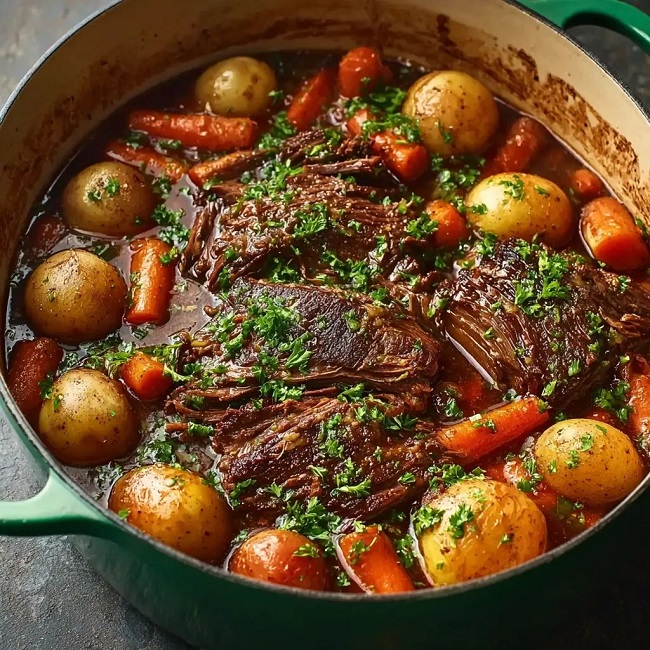
Serving Ideas: Serve with mashed potatoes, crusty bread, or green beans for a hearty family dinner.
Garlic Herb Oven Pikes Peak Roast
Ingredients:
- 3 lb pikes peak roast
- 4 garlic cloves, minced
- 2 tbsp fresh rosemary, chopped
- 1 tbsp fresh thyme, chopped
- 2 tsp salt, 1 tsp black pepper
- 3 tbsp olive oil
- 1 cup beef broth
Instructions:
- Preheat oven to 325°F (163°C).
- Combine garlic, rosemary, thyme, salt, pepper, and olive oil; rub onto roast.
- Place in a roasting pan with beef broth.
- Cover with foil and bake 2.5–3 hours until tender.
- Remove foil and bake an additional 15 minutes to brown the crust.
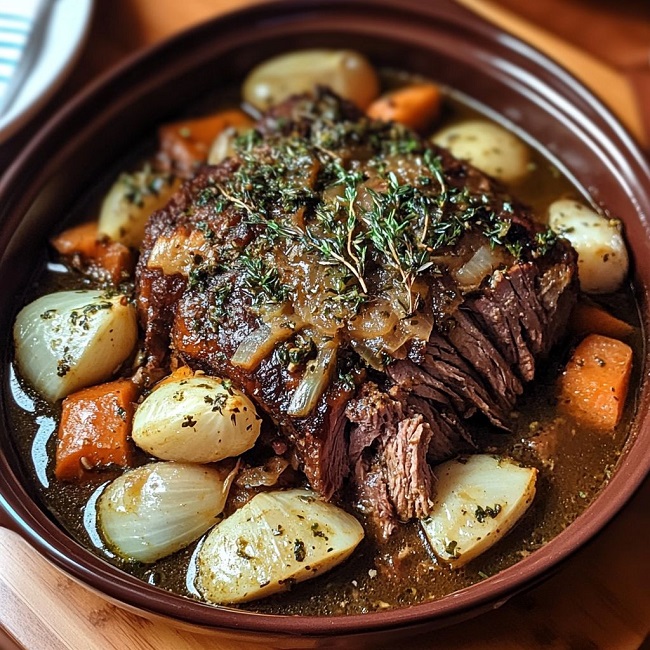
Serving Ideas: Pair with roasted potatoes, sautéed mushrooms, or a fresh green salad.
Red Wine Braised Pikes Peak Roast
Ingredients:
- 3–4 lb pikes peak roast
- 2 cups red wine
- 2 cups beef broth
- 1 onion, chopped
- 3 carrots, chopped
- 2 cloves garlic, minced
- 2 tbsp tomato paste
- 2 tsp salt, 1 tsp black pepper
- 2 tbsp olive oil
Instructions:
- Preheat oven to 325°F (163°C).
- Season roast with salt and pepper; sear in olive oil until browned.
- Add onions, garlic, and tomato paste; cook 2 minutes.
- Deglaze pan with red wine, then add beef broth.
- Cover and bake 3–4 hours until the pikes peak roast is tender and shreddable.
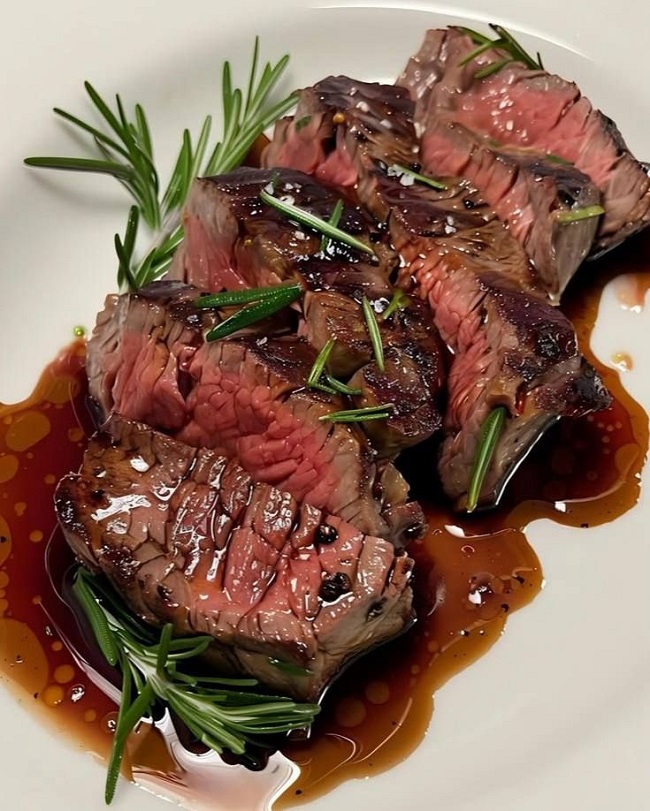
Serving Ideas: Serve with creamy polenta, mashed potatoes, or buttered egg noodles for a comforting meal.
BBQ Smoked Pikes Peak Roast
Ingredients:
- 3–4 lb pikes peak roast
- 2 tbsp paprika
- 1 tbsp brown sugar
- 2 tsp salt, 1 tsp black pepper
- 1 tsp garlic powder
- 1 tsp onion powder
- Wood chips: hickory or oak
- BBQ sauce for basting
Instructions:
- Preheat smoker to 225°F (107°C).
- Mix spices and rub over roast.
- Place in smoker; add wood chips and smoke 5–6 hours.
- Baste with BBQ sauce during the last hour.
- Roast is done when internal temp reaches 190°F and meat is tender.
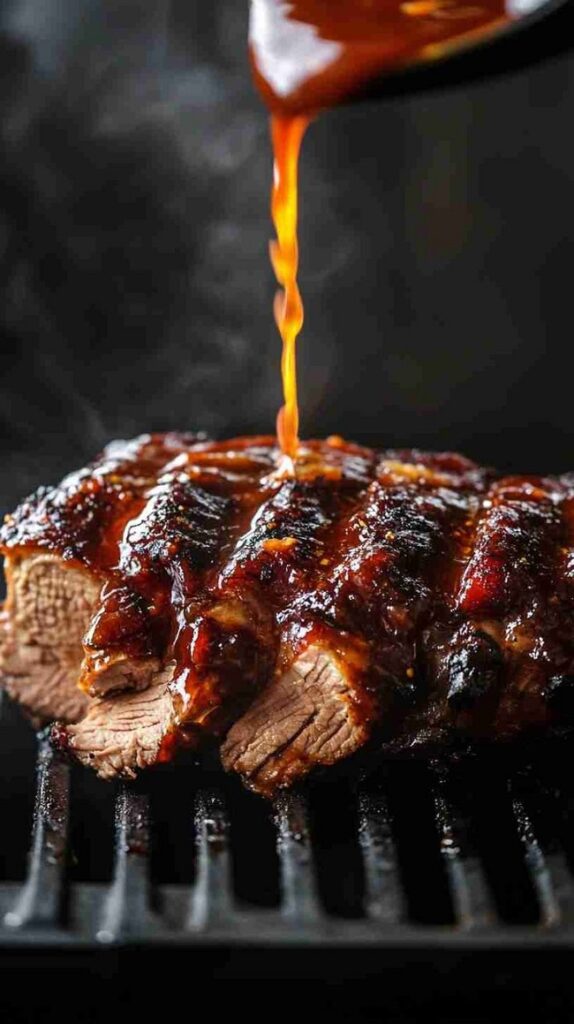
Serving Ideas: Serve with cornbread, baked beans, or coleslaw for a classic BBQ meal.
Tips for Perfect Pikes Peak Roast Recipes
- Always slice against the grain to maximize tenderness.
- Allow resting time after cooking to lock in juices.
- Adjust seasonings and liquid levels based on cooking method.
- Pair with vegetables, starches, or sauces that complement the rich beef flavor.
How to Make Pikes Peak Roast Tender
The pikes peak roast is a lean, flavorful cut of beef that offers incredible taste but can be tougher than premium cuts like ribeye or tenderloin. This is because it comes from the bottom round, a muscle-heavy section of the cow that gets frequent exercise. While the texture may be firm, proper techniques can transform this cut into a juicy, melt-in-your-mouth centerpiece suitable for family dinners, slow-cooked meals, or gourmet dishes.
Why Pikes Peak Roast Is Naturally Tough
Unlike highly marbled cuts, the pikes peak roast contains more connective tissue and less fat, which contributes to its firmness. If cooked quickly at high heat, the meat can become dry or chewy. Understanding its muscle-heavy structure is key to unlocking tenderness and maximizing flavor.
Tenderizing Tips
1. Marinate for Maximum Flavor and Softness
Marination is one of the simplest ways to tenderize a pikes peak roast. Acids like red wine, vinegar, or citrus juice help break down tough muscle fibers. Combine with olive oil, garlic, herbs, and spices, and let the roast marinate for several hours—or overnight—for deeper flavor and softer texture.
2. Cook Low & Slow
Slow, gentle cooking is essential for a tender pikes peak roast. Methods such as braising in a Dutch oven, oven-roasting at 275–300°F, slow cooker recipes, or pressure cooking allow connective tissue to break down gradually. For best results, cook until the internal temperature reaches 190–200°F, producing tender, juicy beef that easily shreds or slices.
3. Cut Against the Grain
Even a perfectly cooked pikes peak roast can be tough if sliced incorrectly. Always cut against the grain—perpendicular to the direction of muscle fibers. This shortens the fibers and ensures every bite is tender and easy to chew.
4. Rest Before Serving
Resting is crucial for maintaining juiciness. Remove the roast from heat and allow it to rest for 10–20 minutes. This lets the juices redistribute throughout the meat, preventing dryness and enhancing flavor.
Bonus Tips for Extra Tenderness
- Consider using a meat mallet or fork-tenderizer before cooking.
- Add aromatic vegetables like onions, carrots, and celery during cooking—they release moisture and natural flavors that enhance tenderness.
- Use a lid or foil during roasting to trap steam and prevent drying.
Pikes Peak Roast vs Other Beef Cuts
The pikes peak roast is a lean, flavorful cut from the bottom round, prized for its affordability and versatility. While it may be tougher than more marbled cuts, it becomes tender and juicy when cooked properly. Comparing it to other popular cuts like chuck roast, brisket, and rump roast can help you decide which is best for your meal and cooking method.
Chuck Roast
Chuck roast comes from the shoulder and is well-marbled, making it ideal for slow-cooked recipes such as stews and pot roasts. The fat content makes the meat juicy and delicious. In contrast, the pikes peak roast is leaner, making it a healthier and more budget-friendly option. When slow-cooked, it can achieve similar tenderness while absorbing herbs, spices, and broths beautifully.
Brisket
Brisket is a fattier cut from the lower chest, rich in connective tissue. It shines in smoking, braising, or barbecue preparations, producing a melt-in-your-mouth texture. The pikes peak roast, being leaner, is better suited for oven roasting, slow cooking, or pressure cooking. While brisket is perfect for long, slow BBQ-style meals, pikes peak roast works well for everyday family dinners where versatility and affordability are priorities.
Rump Roast
Rump roast, also from the hindquarter, is slightly more tender than the pikes peak roast and benefits from braising or roasting. Both are lean cuts that require slow cooking for optimal tenderness. The pikes peak roast often offers a more economical option while delivering excellent flavor and adaptability for various dishes.
Which Cut is Better for Which Situation?
| Cut | Best For | Best Cooking Method |
|---|---|---|
| Pikes Peak Roast | Rich, beefy flavor, tender roast dishes | Braising, roasting, pot roasting, slow-cooking |
| Chuck Roast | Budget-friendly, shreddable beef for tacos, sandwiches, stews | Slow-cooking, braising, making stews and chili |
| Brisket | BBQ, smoky, melt-in-your-mouth texture | Smoking, braising, BBQ, corned beef |
| Rump Roast | Lean, mild beef flavor for traditional roasts and sandwiches | Oven roasting, slow roasting, slicing for sandwiches |
Conclusion
The Pikes Peak roast is a truly versatile and flavorful cut of beef, offering a perfect balance of tenderness and rich, beefy flavor. Whether you’re preparing a classic pot roast, a savory garlic herb oven roast, a rich red wine-braised version, or a smoky BBQ roast, this cut shines in a variety of cooking methods. The Pikes Peak roast is especially well-suited for slow-cooking techniques, allowing the meat to become tender and infused with deep flavors, making it an excellent choice for braising, roasting, or slow cooking.
When compared to other popular beef cuts like chuck roast, brisket, and rump roast, the Pikes Peak roast stands out by offering a more tender texture without sacrificing that rich, beefy taste. Its balance of marbling and muscle provides a flavorful yet tender result, making it a fantastic option for both everyday meals and special occasions.
If you haven’t yet tried the Pikes Peak roast, now is the perfect time to experience its versatility. This cut adapts beautifully to various seasonings, cooking methods, and flavor profiles, ensuring that it can be the star of any dish. Whether you’re cooking for your family or hosting a special gathering, the Pikes Peak roast promises to deliver a satisfying, mouthwatering meal every time. Don’t miss the opportunity to explore this delicious cut of beef and discover why it deserves a place in your culinary repertoire.
FAQs,
What is the best way to cook pikes peak roast?
The best way to cook a pikes peak roast is using slow, moist-heat methods such as slow cooking, braising, or oven roasting at low temperatures. These methods break down tough fibers, producing a tender, flavorful roast perfect for family meals.
Is pikes peak roast tough or tender?
By nature, pikes peak roast is a lean, muscle-heavy cut, so it’s firmer than fattier cuts. However, when cooked low and slow or pressure-cooked, it becomes juicy and tender, ideal for shredding or slicing.
Can I use pikes peak roast for pot roast?
Yes! This cut works wonderfully for pot roast recipes. Its firm texture holds up during long cooking, while absorbing rich flavors from vegetables, herbs, and broth.
How long should I cook pikes peak roast in a slow cooker or oven?
In a slow cooker, cook on low for 8–10 hours or high for 5–6 hours. Oven roasting at 300°F (150°C) generally takes 3–4 hours depending on size. Always check tenderness with a fork.
Can I freeze pikes peak roast leftovers?
Yes, tightly wrap in foil or use an airtight container. Frozen pikes peak roast lasts 2–3 months and reheats well without losing flavor.
Pikes peak roast vs chuck roast – which is better?
Both are excellent for slow-cooked meals. Pikes peak roast is leaner and more budget-friendly, while chuck roast is fattier and richer in flavor. Choose based on cooking method and desired tenderness.